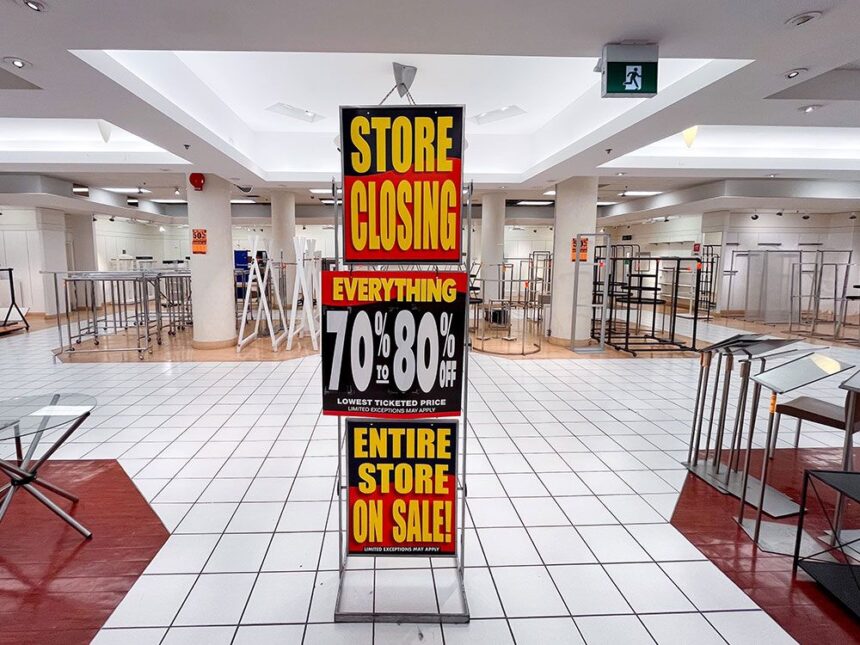The demise of middle-market retail in Canada isn’t a sudden collapse but rather a slow, painful transformation years in the making. When Hudson’s Bay Company announced plans to close its downtown Winnipeg location after 97 years of operation, it marked not an isolated incident but another chapter in the broader retail restructuring affecting communities nationwide.
“We’re witnessing a hollowing out of the middle,” explains Marty Weintraub, national retail practice leader at Deloitte Canada. “Retailers who once served middle-class Canadians with mid-range pricing are finding themselves squeezed from both directions.”
This retail compression follows a pattern familiar to economists tracking middle-class buying power. As disposable income stagnates for many households, consumer spending has polarized toward either discount retailers or premium luxury experiences, leaving traditional department stores and mid-market chains struggling to define their relevance.
The numbers tell a sobering story. According to Statistics Canada, retail sales volume dropped 2.2% in the first half of 2023, with department stores experiencing even steeper declines. Meanwhile, recent Bank of Canada data shows household debt-to-income ratios reaching 180.5% – a historic high that further constrains discretionary spending for middle-income families.
For communities like downtown Winnipeg, these closures represent more than inconvenience. “Department stores were once community anchors,” notes urban planner Susan Richardson, who studies retail environments. “When they leave, it creates a cascading effect on surrounding businesses and public spaces.”
The Bay’s Winnipeg closure follows similar shutdowns in Edmonton, Calgary, and other Canadian cities. Other established chains including Reitman’s, Le Château, and Aldo have either dramatically reduced their footprint or disappeared entirely from Canadian malls in recent years.
What’s driven this middle-market collapse? Several factors converge into a perfect storm for traditional retailers.
First, e-commerce has fundamentally altered shopping patterns. Online retail captured 14.5% of total Canadian retail sales last year, more than double its pre-pandemic share. Amazon Prime‘s rapid delivery network now reaches 95% of Canadian postal codes, creating competitive pressures that brick-and-mortar operations struggle to match.
Second, rising commercial real estate costs have made large-format stores increasingly unsustainable. “Operating a 300,000-square-foot department store in today’s market is like maintaining a mansion you can’t afford to heat,” says commercial real estate analyst David Tartaglia.
Third, changing consumer values have shifted. Younger shoppers demonstrate less brand loyalty and more desire for either deeply discounted basics or highly curated experiences – neither of which traditional department stores excel at providing.
“Mid-market retailers got caught trying to be all things to all people,” observes retail strategist Cassandra Williams. “In today’s fragmented market, that’s a recipe for irrelevance.”
The transformation manifests differently across Canada. While some urban centers see luxury retail flourishing in concentrated districts, suburban areas have witnessed explosive growth in value-oriented stores like Dollarama, which opened its 1,400th Canadian location this year.
This isn’t simply a Canadian phenomenon. Similar patterns have emerged across North America, with once-dominant retailers like JCPenney, Sears, and Kohl’s facing existential challenges in the United States.
For shoppers, the impact varies by geography and income level. While higher-income consumers in major urban centers enjoy expanded premium options, many middle-class Canadians in smaller communities face reduced selection and convenience.
“We’re seeing retail deserts forming in some areas,” warns consumer advocate Michael Sanderson. “When affordable, quality retail disappears from a community, it disproportionately affects those with limited transportation options or digital literacy.”
Some retailers have found ways to navigate this challenging landscape. Simons, the Quebec-based department store, has invested heavily in both physical store experiences and digital integration. Indigo Books & Music pivoted toward lifestyle merchandise while maintaining its cultural retail identity. Canadian Tire has leveraged its trusted brand and essential product categories to remain relevant.
What these survivors share is clarity about their value proposition – something missing from many struggling mid-market chains.
“The retailers that will survive aren’t necessarily the biggest or the cheapest,” says Weintraub. “They’re the ones who understand exactly why customers should choose them over alternatives.”
For communities facing major retail closures, the path forward often involves reimagining commercial spaces entirely. Former department stores across Canada have transformed into everything from university campuses to medical centers, tech hubs, and mixed-use developments combining housing with smaller retail footprints.
As Bay Street watches these retail transformations, investors increasingly distinguish between property types. While power centers anchored by grocery and essential retailers maintain stable valuations, traditional enclosed malls anchored by department stores face significant repricing and redevelopment pressure.
For Canadian consumers, this retail restructuring requires adaptation. Online comparison shopping, increased travel to retail clusters, and greater reliance on specialty stores often replace the one-stop department store experience of previous generations.
The future retail landscape will likely feature fewer but more focused physical stores complemented by sophisticated digital options. The middle won’t disappear entirely, but it will look dramatically different from the department store model that shaped Canadian commerce throughout the 20th century.
“We’re not witnessing the end of retail,” concludes Williams. “We’re seeing the end of undifferentiated retail. For stores to earn their physical presence in communities, they must offer something truly distinct – whether that’s extraordinary value, exceptional service, or experiences you simply can’t replicate online.”
In that transformation lies both challenge and opportunity for retailers, communities, and consumers across Canada.






